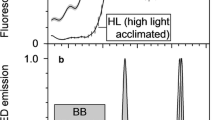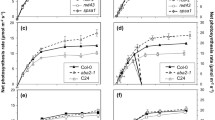Abstract.
Plants acclimate to changes in light quantity by altering leaf-cell development and the accumulation of chloroplast components, such that light absorption is favoured under limiting illumination, and light utilisation under non-limiting conditions. Previous evidence suggests an involvement of a high-light photosynthetic redox signal in the down-regulation of the accumulation of the light-harvesting complexes of photosystem II (Lhcb) and the expression of the Lhcb genes, and of a blue-light signal in the control of leaf development and in the increase in photosynthetic capacity, as affected by the accumulation of ribulose-1,5-bisphosphate carboxylase/oxygenase (Rubisco). We examined the internal anatomy of leaves, the ultrastructure of chloroplasts and accumulation of light-harvesting complexes and Rubisco in wild-type Arabidopsis thaliana (L.) Heynh. and in mutants in each of the three known blue-light photoreceptors, cryptochrome 1, cryptochrome 2 and phototropin, as well as a mutant in both cryptochromes. Our results indicate an extensive capacity of the Arabidopsis mesophyll cells to adapt to high light fluence rate with an increase in palisade elongation. Under high light, chloroplasts showed increased starch accumulation and reductions in the amount of granal thylakoids per chloroplast, in the proportion of chlorophyll b relative to chlorophyll a, and in the accumulation of the major Lhcb polypeptides. The responses were similar for all four mutants, with respect to their wild types. The results are consistent with either a complete redundancy in function between cryptochromes and phototropin, or their absence of involvement in the light-quantity responses tested. We observed minimal effects of light quantity on Rubisco accumulation over the range of fluence rates used, and conclude that elongation of palisade mesophyll cells and accumulation of Rubisco are controlled separately. This indicates that light acclimation must be the result of a number of individual elementary responses. Quantitative differences in the acclimatory responses were observed between the Landsberg erecta and Columbia wild-type ecotypes used.
Similar content being viewed by others
Author information
Authors and Affiliations
Additional information
Received: 4 April 2000 / Accepted: 14 July 2000
Rights and permissions
About this article
Cite this article
Weston, E., Thorogood, K., Vinti, G. et al. Light quantity controls leaf-cell and chloroplast development in Arabidopsis thaliana wild type and blue-light-perception mutants. Planta 211, 807–815 (2000). https://doi.org/10.1007/s004250000392
Issue Date:
DOI: https://doi.org/10.1007/s004250000392




